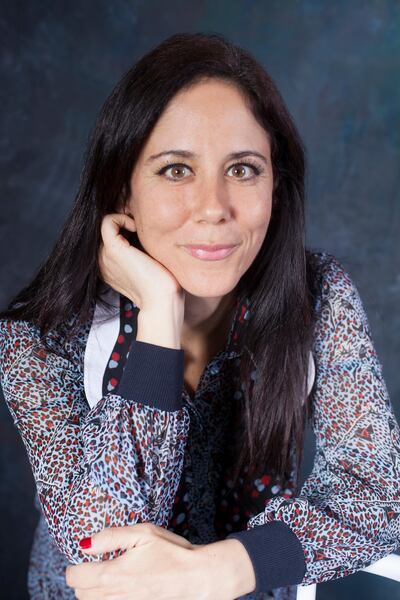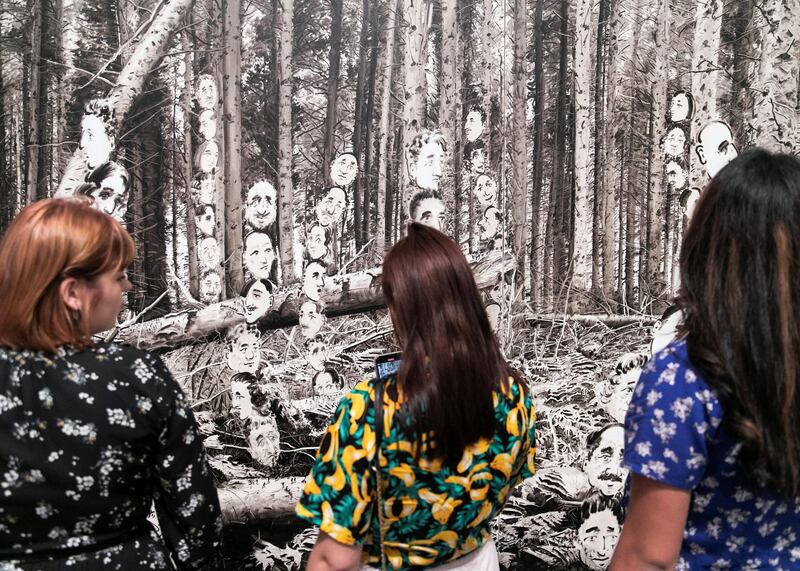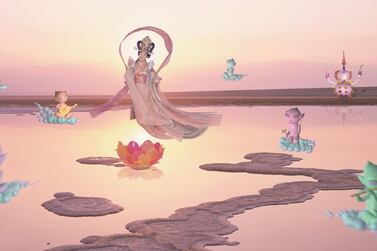Following in the footsteps of art fairs around the world, Abu Dhabi Art this year will take place online as the pandemic continues to impose restrictions on travel.
The usual runtime of the fair has been extended from three days to a week, from November 19 to 26. It has also modified its programme to adapt to the new format, introducing additional curated exhibitions and sections, as well as bringing back performances and dropping one of its artist commission initiatives.
There will be six guest curators for the 12th iteration of the event this year, two more than last, each presenting an online exhibition with a specific geographic focus or theme.
“We’ve amplified that collaboration between curators and galleries this year,” says Dyala Nusseibeh, director of Abu Dhabi Art. Her hope, she says, is that the curated sections will highlight emerging artists who may otherwise be overlooked in online fairs.
“What you often find is that collectors will buy artworks by artists they’re already familiar with, but newer artists might not have such success online, which is a challenge, especially with Abu Dhabi Art, where we often show younger or emerging artists alongside established ones. In that sense, whether it’s focus on geography or curatorial concept, there will be different things that someone can draw out from their experience online,” she says.

Among the art fair's curators this year is Simon Njami, the writer and curator behind Africa Remix: Contemporary Art of a Continent, a landmark exhibition held in Europe in 2005, and its accompanying book. His section, The Day After, will focus on artists from the African continent linked by works that address the theme of time.
Gallerist Ashwin Thadani returns this year with another India Focus section, while Sung woo Kim, who works with the Busan Biennale, will feature Korean artists. Nada Raza, who lives and works in the UAE, will curate a section dedicated to artists represented by the country's galleries.
Rose Lejeune of London’s Delfina Foundation is in charge of this year’s performing arts programme, which has been hit tremendously hard by closures due to the Covid-19 pandemic. These issues will be addressed within the section.
“We’re thinking about the nature of performance when no one can attend anything," Nusseibeh says. "Everything’s done remotely and online, and what can be done with that.”
Lejeune’s section replaces Durub Al Tawaya, the fair’s usual performance programme, which was previously curated by Tarek Abou El Fetouh, but was not held last year.
Maya El Khalil, curator of this year's Jeddah’s 21,39, organised by the Saudi Art Council, is leading the fair’s Beyond: Emerging Artists Programme, which focuses on commissioning projects by Emirati artists. El Khalil is working with three artists whose names will be announced at the end of the month.
Their artworks will be exhibited in Abu Dhabi, as perhaps the only physical component of the fair, although the projects will be shown online, too.
Beyond: Artist Commissions, which supported the production of site-specific works by international artists in Al Ain, will not take place this year. “Like many fairs globally, virtual became the only possible option for us,” Nusseibeh says.
One of the fair’s main concerns, she says, is how to stand out from the “endless stream of images” that have filled up digital art fairs and exhibitions in the wake of the pandemic.
“It’s exhausting and it doesn’t really work, so that was something we had to think about. Another was that a lot of fairs feel very impersonal. There’s no sense of connection with what you’re looking at online. It feels very anonymous,” she says.
To combat this, Abu Dhabi Art has boosted its multimedia material with videos, 360-degree tours, virtual viewing rooms and more one-on-one discussions, Nusseibeh says.
“We’re thinking about what it is like when someone comes on the website and has a look – it’s not just looking at images. We were trying to create more personal moments for people through things like inviting artists to do video interviews in their studios and have them take you around those spaces. Galleries also talk about their booths and why they’ve chosen those works,” she says.
This move came out of the fair’s summer catalogue and online campaign, a weekly artist video focusing on works under $5,000.
“We’ll also do a number of smaller events where people can have a live session and ask curators and artists things directly online,” Nusseibeh says. Details of the talks programme have not yet been announced.
In addition to the curated section, there will be a general section where galleries present works for sale, although the number of participating names is still unknown. Nusseibeh reveals, however, that the galleries have not been charged attendance or application fees this year, and that Abu Dhabi Art is also covering the expenses for video production and website development. The virtual event will also be free for all visitors to access.
“Abu Dhabi Art has always been a fair with a wider remit," she says. "It’s not run by a commercial entity. It’s run by the Department of Culture and Tourism, and so that remit is to support the art ecosystem, to support the galleries and artists and art professionals that come together for it, and to play that wider role.” Currently, fair organisers are welcoming galleries that have participated in Abu Dhabi Art since 2017.
Despite the challenges of navigating the virtual realm, these new platforms and formats have also brought in new audiences – specifically, younger and more international ones. Nusseibeh points to an anecdote from the summer campaign, when an anonymous collector from New York bought four artworks after coming across them on Instagram. “We’re connecting globally with people that we might not have welcomed to Abu Dhabi before because you’re suddenly more accessible online,” she says.
“I find that the younger generation have much more confidence looking at these works online. So in terms of our market growth, the online-savvy collector base is one that we’re going to be growing.”
Abu Dhabi Art will run from November 19 to 26 on abudhabiart.ae







